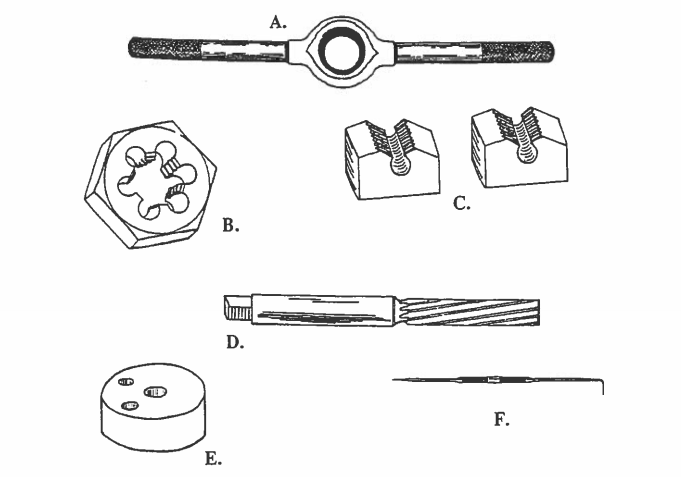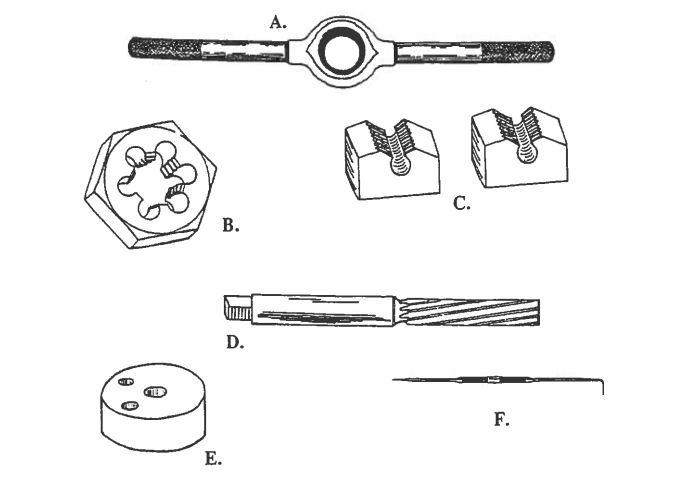Lesson 6: Dies and Reamers
WORD LIST
|
1. shaft |
the long, thin part of something like the wood in an arrow. Example: The flag is usually hung at the end of a shaft. |
|
2. cylinder |
a solid piece with two round ends and straight sides. Example: A soda pop can is shaped like a cylinder. |
|
3. surround |
to flow around or be all around something. Example: The old man was surrounded by his children at the party. |
|
4. damage |
to cut, break, scratch, mark or injure in any way. Example: Sometimes the threads on threaded pieces are damaged when a machinist uses a wrong tool. |
|
5. split |
to cut something into two pieces. Example: My sister and I split the money; she got $20 and I got $20. |
|
6. halves |
more than one half; one of two equal parts. Example: A split die had two halves that fit around the round workpiece. |
|
7. smooth |
very even: having no bumps or raised parts. Example: A baby’s skin is very smooth. |
|
8. exact |
correct, accurate, not differing from what is required. Example: She paid the exact amount of the bill, $12.38. |
|
9. diameter |
the length of a line drawn from one side of a circle to the other and passing through the center. Example: the diameter of the gear is exactly 12.015 inches. |
|
10. guide |
a person or thing which leads, directs, shows which way to go. Example: A map is good guide for finding new places. |
|
11. fine |
thin, not wide. Example: He drew a fine line with his pencil. |
|
12. friction |
the resistance of two objects to moving across each other when they are touching. Example: When you rub your hands together, the friction from the rubbing will cause that. |
Vocabulary Practice
DIES AND REAMERS
|
In the last lesson, you studied taps which are used to cut threads inside a hole. Into this threaded hole goes a threaded bolt or threaded shaft. You will want to be able to cut external threads into a cylinder-shaped workpiece; you will use dies and a die stock to do that. The dies have teeth that surround the cylinder and cut into the metal as the die is turned. Dies come in many different sizes. The die stock is like a wrench – it holds the die and provides handles for turning. As with taps, cutting fluid* is used frequently to help the die to cut the metal. There are two kinds of commonly used dies: (1) the solid die – it is not adjustable and is often used for repairing damaged threads by re-cutting them; (2) the adjustable split die – it is a pair of die halves that fit into a die stock. There is a screw which allows you to adjust the cutting depth; you can then cut threads that are over or under the standard depth. When you use a split die, make sure that the two halves are the same size. Both taps and dies are made of high-quality tool steel, hardened and ground. Another tool is the hard reamer; it is used to finish the inside of a hole that has already been drilled. The reamer removes a small amount of material to make a very accurate, smooth hole, with exact diameter. The bench block has several holes of different sizes drilled through it. This block can be a guide to keep hand taps straight when cutting threads. The scriber is a drawing tool with a hardened steel point used to draw fine lines onto the rough stock. The lines will tell the machinists where to cut or drill or do other operations on the workpiece. On a double-end scriber, both ends have points; one of the ends is bent to enable reaching into narrow places. *The cutting fluid helps (1) to reduce the temperature while cutting, (2) to reduce friction, and (3) to make the tool last longer by decreasing use.
|
Exercise 1

Exercise 2

Exercise 3

Exercise 4

Exercise 5
Reread Dies and Reamers above. Read the following statements and answer “T” if the statement is true; answer “F” is the statement is false.
End of Lesson Test
Listening Test
Look at the pictures. Listen to the words. Write the letters in the spaces below.
Click here to listen to the recording.

Writing Test
Look at the pictures. Write the names in the spaces below.


